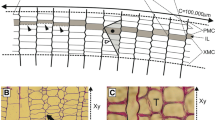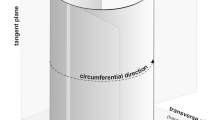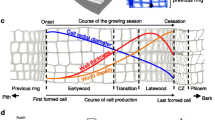Abstract
The radial growth of conifer trees proceeds from the dynamics of a merismatic tissue called vascular cambium or cambium. Cambium is a thin layer of active proliferating cells. The purpose of this paper was to model the main characteristics of cambial activity and its consecutive radial growth. Cell growth is under the control of the auxin hormone indole-3-acetic. The model is composed of a discrete part, which accounts for cellular proliferation, and a continuous part involving the transport of auxin. Cambium is modeled in a two-dimensional cross-section by a cellular automaton that describes the set of all its constitutive cells. Proliferation is defined as growth and division of cambial cells under neighbouring constraints, which can eliminate some cells from the cambium. The cell-growth rate is determined from auxin concentration, calculated with the continuous model. We studied the integration of each elementary cambial cell activity into the global coherent movement of macroscopic morphogenesis. Cases of normal and abnormal growth of Pinus radiata (D. Don) are modelled. Abnormal growth includes deformed trees where gravity influences auxin transport, producing heterogeneous radial growth. Cross-sectional microscopic views are also provided to validate the model's hypothesis and results.
Similar content being viewed by others
References
Barlow, P.W., Brain, P., Powers, S.J., 2002. Estimation of directional division frequencies in vascular cambium and in marginal meristematic cells of plants. Cell Prolif. 35, 49–68.
Bannan, M.W., 1950. The frequency of anticlinal divisions in fusiform cambial cells of Chamaecyparis. Am. J. Bot. 37, 511–519.
Bannan, M.W., 1955. The vascular cambium of and radial growth of Thuja occidentalis. Can. J. Bot. 33, 113–138.
Cominetti, R., Padilla, F., San Martín, J., 2002. Field methodology for reconstruction of a Pinus radiata log. NZ J. Forestry Sci. 32(3), 309–321.
Estelle, M., 1998. Polar auxin transport: New support for an old model. Plant Cell 10, 1775–1778.
Forest, L., San Martin, J., Padilla, F., Chassat, F., Giroud, F., Demongeot, J., 2004. Morphogenetic processes: Application to cambial growth dynamics. Acta Biotheor. 52(4), 415–438.
Friml, J., Wisniewska, J., Benkova, E., Mendgen, K., Palme, K., 2002. Lateral relocation of auxin efflux regulator PIN3 mediates tropism in Arabidopsis. Nature 415, 806–809.
Funada, R., 1990. Distribution of indole-3-acetic acid and compression wood formation. Holzforschung 44, 331–334.
Harris, J.M., 1991. Structure of wood and bark. In: Kininmonth, J., Whiteside, I. (Eds.), Properties and uses of New Zealand Radiata Pine. Vol. 1. Wood properties, Chaps. 2 and 3. New Zealand Ministry of Forestry. Forest Research Institute.
Kramer, E.M., 2001. A mathematical model of auxin-mediated radial growth in trees. J. Theor. Biol. 208, 387–397.
Kramer, E.M., 2002. A mathematical model of pattern formation in the vascular cambium of trees. J. Theor. Biol. 216, 147–158.
Larson, P.R., 1994. The Vascular Cambium. Development and Structure. Springer-Verlag, Berlin, p. 725.
Ljung, K., Bhalerao, R., Sandberg, G., 2001. Sites and homeostatic control of auxin biosynthesis in Arabidopsis during vegetative growth. Plant J. 28, 465–474.
Padilla, F., 2001. Estudio de la deformación del fuste causada por polilla del brote rhyacionia buoliana en Pinus radiata en la décima región. Memoria de Ingeniero forestal. Facultad de Ciencias Forestales. Universidad de Chile.
Schrader, J., Baba, K., May, S.T., Palme, K., Bennett, M., Bhalerao, R.P., Sandberg, G., 2003. Polar auxin transport in the wood-forming tissues of hybrid aspen is under simultaneous control of developmental and environmental signals. Proc. Natl. Acad. Sci. 100, 10096–10101.
Smith, G.S., 2001. Plant cell division: building walls in the right place. Nat. Rev. Mol. Cell Biol. 2, 33–39.
Thom, R., 1972. Stabilité structurelle et morphogenèse. Essai d'une théorie générale des modèles. W. A. Benjamin, Inc, Massachusetts.
Uggla, C., Magel, E., Moritz, T., Sunderg, B., 2001. Function and Dynamics of Auxin and Carbohydrates during Earlywood/Latewood Transition in Scots Pine. Plant Physiol. 125, 2029–2039.
Uggla, C., Mellerowicz, E.J., Sundberg, B., 1998. Indole-3-acetic acid controls cambial growth in Pinus sylvestris (L.) by signalling. Plant Physiol. 117, 113–121.
Watanabe, U., Minoru, M., Norimoto, M., 2002. Transverse young's moduli and cell shapes in coniferous early wood. Holzforschung 56, 1–6.
Zimmermann, M., Brown, C., 1971. Trees: Structure and Function. Springer-Verlag,. New York, p. 336.
Author information
Authors and Affiliations
Additional information
An erratum to this article is available at http://dx.doi.org/10.1007/s11538-006-9157-x.
Rights and permissions
About this article
Cite this article
Forest, L., Demongeot, J. Cellular Modelling of Secondary Radial Growth in Conifer Trees: Application to Pinus Radiata (D. Don). Bull. Math. Biol. 68, 753–784 (2006). https://doi.org/10.1007/s11538-005-9004-5
Received:
Accepted:
Published:
Issue Date:
DOI: https://doi.org/10.1007/s11538-005-9004-5




